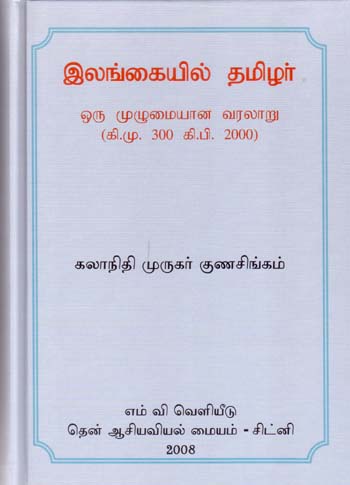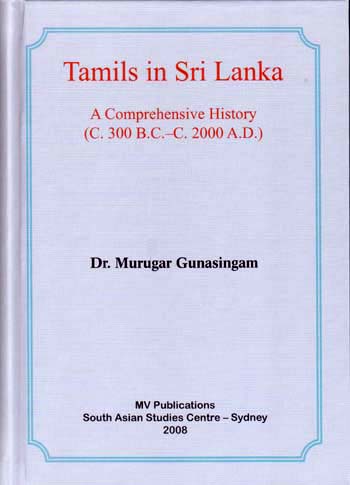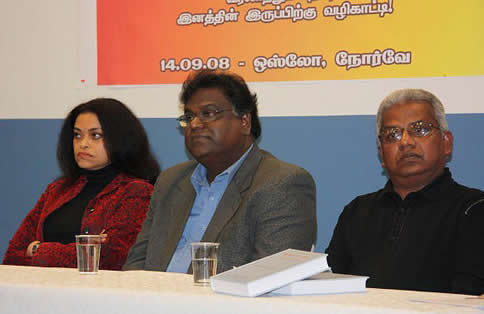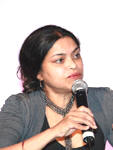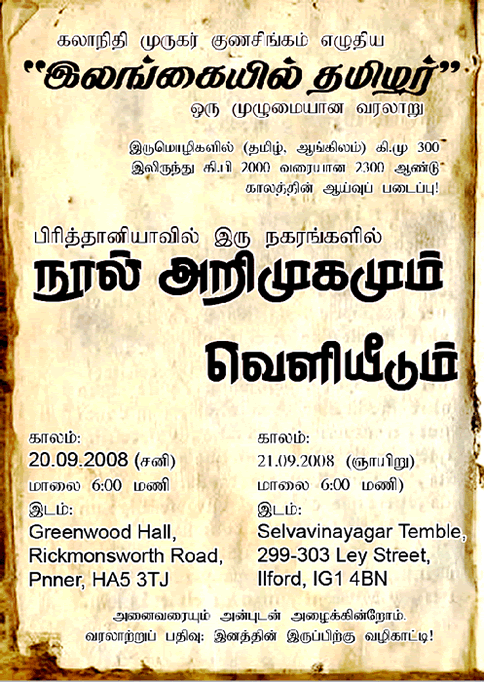Many renowned Sinhalese and Tamil Historians Archaeologists Anthropologists and Linguistic Scholars as well as Indian, American and British Scholars have engaged in research, on the ancient history of Sri Lanka for more than 30 years, conducting Archaeological excavations.
These excavations were carried out in various parts of Sri Lanka and their findings published. However, some excavations have been suspended while, in other cases, the findings have not been released. In particular, there are many instances where excavations in the northern regions of Sri Lanka were suspended and the findings withheld. However, unbiased and honest historians have openly published the findings of their studies on this subject.
Many facts related to the ancient history of Sri Lanka and its ancient people have been brought to light on the basis of archaeological evidence from excavations. But, various difficulties have arisen in regard to understanding the early Stone Age people, their antiquity and their race. Nevertheless, the scholars referred to above generally accept that the ancient people of Sri Lanka belonged to the Dravidian Language family and followed the Dravidian (Megalithic) culture of 'Urn Burials'. The findings of these scholars also show that there was a strong similarity between the ancient people of Sri Lanka and those of India, particularly from Tamil Nadu, Kerala, Kannada and the Andhra regions in South India where Dravidian languages are spoken.
Geologists and archaeologists are of the general opinion that as the result of a natural calamity Sri Lanka broke off from the Indian landmass and became an island many thousands of years ago. Therefore the ancient people of South India and Sri Lanka were of the same ethnic stock. This has been further established by findings relating to their culture, language and religion that show that the people of these two regions were closely connected.
In short, it emerges that the ancient people of Sri Lanka belonged to the Dravidian family and spoke Tamil, one of the ancient languages of the Dravidian language family. However, Pali and Sinhalese historical records and literature claim that the ancient people of Sri Lanka belonged to the Aryan language family and spoke Sinhalese, an Aryan language and that they came from North India. To date no archaeological evidence has been found to support these theories.
Sinhalese historians based their theories that the ancient people of Sri Lanka were Sinhalese largely on historical records found in the Deepavamsa and Mahavamsa Buddhist chronicles written in the fourth and filth centuries A.D. and on ancient stone inscriptions written in the North Indian languages of Pali and Sanskrit. These historians are particularly inclined to use the Mahavamsa. written in the fifth century A.D., as a main source. The Mahavamsa begins with the historical legend of Vijaya who was deported from North India and arrived in Sri Lanka in the fifth century BC.
In addition, the Mahavamsa also speaks of the three visits of Lord Buddha to Sri Lanka and the establishment of Buddhism in Sri Lanka by the Buddhist mission sent to Sri Lanka by the Maurya Emperor Asoka in the third century BC. This mission was led by his son and Buddhist priest Mahinda. The records of the Mahavamsa along with other historical documents and writings also tell of Devanampiya Tissa, the king of the Anuradapura Kingdom, who embraced Buddhism in the same period.
These accounts have naturally led historians in general to consider that the history of Sri Lanka begins with the third century BC. However, there is no reliable historical evidence of the arrival of Vijaya and his associates in the fifth century BC or of his rule in Sri Lanka. It is possible to infer that, Mahanama, the author of the Mahavamsa, witnessed the decline and disorientation of Buddhism in India during the fifth century BC. Due to his devotion to Buddhism and desire to consolidate this religion in Sri Lanka he decided to write the Mahavamsa. It is also possible that he began his chronicle with the legend of Vijaya with the sole purpose of linking Buddhism with its relationship to North Indian languages as a means to achieve his goals.
The important fact that must be considered in this context is that Saivaism was firmly established in Sri Lanka long before the arrival of Buddhism on the island. The kings of the Anuradapura Kingdom had been Saivaites before the advent of Buddhism. Besides, the Kingdom of Anuradapura was a well developed and strong kingdom in the third century BC, a status that would have required centuries to attain. Would it have been possible for Vijaya who arrived in Sri Lanka only in the fifth century BC to start from scratch and build up such a full-fledged kingdom in Anuradapura? It is apparent that the Kingdom of Anuradapura originated and gradually developed into a strong kingdom through many centuries and that the people who established the kingdom were Tamils of the Dravidian family. Tamil culture and Saiva religion were practiced in ancient Sri Lanka as Tamils were the ancient people of Sri Lanka, a fact established by the archaeological evidence that has come to light.
The culture, language, and religion of an ethnic people are the most significant factors determining their unique identity. Archaeological evidence shows that the ancient Dravidian people of ancient Sri Lanka, influenced by the arrival of Buddhism and the North Indian languages associated with it, gradually embraced Buddhism, its cultural traditions and the languages related to it.
For instance, archaeological findings prove that Buddhism enjoyed an influential status as the religion of the people in the traditional Tamil regions in the north, east and northwest parts of Sri Lanka, during the first two centuries BC. Would it be right to call these people Sinhalese on the basis that Buddhism was their religion in the early historical period? Archaeological studies clearly reveal that Dravidian people were living in the Puttalam and Negombo areas in the northwest region of Sri Lanka from ancient times.
However, the majority of these people, due to socio-economic activities and transitions over the past 150 years, have become Sinhalese and now speak the Sinhalese language. Besides, the majority of Saivites in the Jaffna peninsula were converted to Catholicism during the foreign rule of the Portuguese invaders. Another interesting instance in this context is the fact that the descendents of two significant Chetty families who migrated to Sri Lanka from Tamil Nadu five generations ago became fervent Buddhist Sinhala nationalists, Prime Ministers and Presidents in Sri Lanka.
It can be surmised from these matters that this same process of assimilation was a common phenomenon experienced throughout ancient Sri Lanka. The history of Sri Lanka, from the third century A.D. to the ninth century A.D., is permeated with the influence of Buddhism and Buddhist culture. This includes from early historical times, the intrusion of Pali and Sanskrit languages and their spread among the ancient Tamils of Sri Lanka and their Dravidian culture, as well as the origin of the Sinhalese language from Sanskrit, Pali and Tamil languages. The younger generation is left with the task of engaging with history and scientific methods to subject this historical period to deep and unbiased studies and write its history with intellectual integrity. When taking up this task, they should strive to find a fitting solution to the ethnic issue that has become an infested sore in Sri Lanka.
Two significant events took place in Sri Lanka following the tenth century A.D. in the wake of the Cola domination of Sri Lanka. The first is that the people who identified themselves as Sinhalese shifted their seats of rule from the ancient kingdoms of Anuradapura and Polanaruwa towards South Sri Lanka. The second was the Tamils moved their ruling structures from these same regions to the north and east of the island.
Consequently, the ancient kingdoms of Anuradapura and Polanaruwa, abandoned by both the Sinhalese and the Tamils, were engulfed by the jungle that temporarily separated the two ethnic groups for the next four or five centuries. As a result, the Sinhalese developed into a separate ethnic people with their distinct Buddhist religion and culture and Sinhalese language while the Tamils, in their traditional regions in the north, east and northwest of Sri Lanka began to establish their kingdoms under the newly risen Jaffna Kingdom, maintaining their distinct Tamil language, culture and Saiva religion.
This situation did not last long. The Sinhalese and Tamil kingdoms declined and eventually succumbed to the Portuguese invaders. The Kingdom of Kandy, however, retained its sovereignty and resisted capture by the Portuguese. The Tamils lost their kingdom forever as a result of Portuguese invasion, and the foreign Catholic religion was forcibly thrust on them. Many were obliged to relinquish their Saiva religion and follow Catholicism and its culture. Above all, they were impoverished by wholesale Portuguese exploitation of their economic resources. This situation allowed the Portuguese to amass great wealth.
The Tamils lost their sovereignty, religion, economic infrastructure and wealth and were reduced to slaves in their own land. It is a bitter historical truth that it was not only the Portuguese who were responsible for this state of affairs but also the competitiveness, jealousy, lack of co-operation and patriotism among the Tamils as well as the evil dowry system and social disparities that existed among them.
This same situation has continued from the time the Tamils and Tamil regions became enslaved to the Portuguese in the sixteenth century. It is unlikely this situation can be changed until the Tamil politicians and officials truly realise the gravity of the situation and apply themselves sincerely to solving these urgent problems. These are the people who have to decide whether or not the Tamils are to continue living as slaves and refugees.
The Dutch, who succeeded the Portuguese, dominated Sri Lanka for 150 years and also amassed wealth by unscrupulous means. They exploited the Tamils and their regions just as the Portuguese did. The Portuguese could be said to have sucked the blood of the Tamils but the Dutch did not stop there but consumed their flesh also. This further reduced the Tamils to utter poverty. The Dutch spread Protestantism, their new brand of Christianity among the forcibly converted Tamil Catholics in the Jaffna peninsula. Dutch documents provide sufficient proof that the Tamils, already afflicted by Portuguese occupation and atrocities, were further severely affected by intense Dutch exploitation of their economic resources along with their religious activities to promote Protestantism among them.
The forced indoctrination of their respective religions and the introduction of western culture to the Tamils in the Jaffna peninsula by the foreign invaders from Portugal and the Netherlands were their sole contributions to the Tamils and their regions, the impact of which is evident even in the present day. However, the Christian missionaries, both Portuguese and Dutch, established schools in the peninsula to impart religious education in addition to a range of basic subjects. Tamil society, for the first time, was exposed to an organised system of education along western principles. It cannot be denied that this experience prepared them for the modern educational methods of the British colonial rule and enabled them to adapt to the judicial, administrative and economic infrastructure of the British.
The British colonial rule that began in the 1796 in Sri Lanka ushered in changes and new enterprises in the island generally and the Tamils and their regions in particular. The British, like their two predecessors, showed a keen interest in propagating Protestantism with the help of their missionaries who used education to spread their religion. As a result, the Tamils gave English education and Tamil education a primary place in their lives.
The prevailing caste discrimination, socio-economic disparities, lack of land and the oppressive dowry system in the Tamil regions, particularly in the Jaffna peninsula, impelled the Tamils to seek education. Parents invested in their children's education in the hope and expectation that their success in examinations would open up employment opportunities for them in the public and private sector in Sri Lanka as well as in foreign countries such as India and Malaya (Malaysia and Singapore).
True to their expectations, educated Tamils were able to acquire government and private employment in Sri Lanka, India and Malaya and earn a permanent income. This advancement in turn brought social development and progress in various spheres and Tamil society was gradually transformed into an educated society. However, this opportunity was not widely available in the undeveloped Tamil regions.
The dedicated interest shown by the British in the field of education resulted in the establishment of hundreds of primary and secondary schools in the Jaffna peninsula with various missionaries functioning as their driving force. The Tamils also, just as the missionaries established Christian English schools, opened up Saiva English schools. Saivaism and the Tamil language experienced a renaissance while Saiva temples and halls were built in great numbers due to the religious tolerance of the British rulers. This progress in education contributed immensely to various positive developments in the fields of religion, arts, culture, language, literature, socio-economics and politics.
The establishment of the infrastructure of finance, justice and administration and the efficient functioning of these structures in the early British rule helped develop the country economically as well as consolidate its administration and law and order. The population began to increase in this peaceful and thriving atmosphere. Roads and bridges were built and health services improved remarkably. This progress in turn paved the way for the Tamils in the north and east to establish contacts and develop mutual understanding with the Sinhalese in the south.
The Tamils, particularly the English-educated Tamils, already disturbed by conversion to Christianity by the missionaries and the spread of western culture among them, rose in protest and reacted against steps taken by the British government. These protest activities relating to culture and economics in turn became factors that kindled the consciousness of the Tamils. The spirit of protest manifested itself in the spheres of society_ religion, culture and language and resulted in the politically motivated rise of Tamil nationalism. The British constitutional reforms and political activities connected to them were the fundamental reasons for the rise and growth of Tamil nationalism.
The Colebrook constitutional reforms introduced in 1833, brought the north and east regions of Sri Lanka, hitherto administered as a separate unit. under a single centralised administrative system based in Colombo. This disoriented the longstanding territorial integration of the Tamils and threatened their national identity.
The 1921-24 Manning constitutional reforms among others that followed were the first to create a permanent divide between the Tamils and Sinhalese ethnic communities. The Donoughmore constitutional reforms introduced in 1931 added their share to compound the situation by implementing universal franchise, abolishing the system of territorial representation and replacing it with communal representation. This resulted in more representatives from the Sinhalese community securing seats in the State Assembly and caused great antipathy and rage among the Tamils and their political leaders. The Soulbury constitutional reforms introduced in 1947 were also partial to the Sinhalese majority representatives. They were drawn up in keeping with the draft proposals submitted by their Board of Ministers and passed in the House of Representatives with the majority of Sinhalese representatives voting in favour. The British ruling powers forcibly implemented this political constitution modeled on the Westminster Parliamentary system as practised in Britain on a country consisting of two Nations, the majority Sinhalese nation and a minority Tamil nation.
In the 1947 general elections held under the newly introduced constitution. the Sinhalese political parties secured the majority representation in Parliament and thereby became the rulers of the country. When the British finally granted independence to Sri Lanka they handed over the government to the Sinhalese majority community leaving the Tamils with a refugee status. The fundamental cause for the loss of thousands of Tamil lives and the destruction of their property in the 60 years following independence was the British government's violation of the trust placed in them by the Tamils. Sinhalese political leaders, by compiling and submitting erroneous statistics to the British rulers, were able to secure sole sovereignty over the whole country, their numerical majority being the only claim.
The Tamil political leaders, due to their dearth of political foresight and propelled by self-promoting motives sought political refuge with the majority Sinhalese political leaders. Safeguards in the form of special Acts in the Soulbury constitution aiming to protect the political rights of the minorities were blatantly abandoned by the Sinhalese majority government within a few months of Sri Lanka gaining independence in 1948.
From 1948 onwards, the Indian Tamils were stripped of their citizenship and their right to vote. Pre-planned Sinhalese colonisation in the traditional Tamil territories was vigorously and systematically implemented. These activities of the government most severely affected Tamil representation in the House of Representatives and the traditional territories of the Tamils.
The `Sinhala Only' Act implemented in 1956 which made Sinhalese the official and national language of the State and granted Buddhism the status of State Religion posed serious threats to the national status and identity of the Tamils in relation to their language and religion. Employment opportunities in considerable numbers were denied to Tamils by the partial activities of the government. Tamil students were denied opportunities in higher studies by the introduction of biased schemes such as 'Standardisation' and the 'Quota System' that were implemented to select candidates for universities.
All fundamental democratic rights such as the freedom to congregate and freedom of expression were largely denied to Tamils. Whenever the Tamil political leaders engaged in passive non-violent protest demonstrations demanding their political rights, the armed forces were used to crush them by attacking demonstrators, forced dispersal of their gatherings and the arrest of Tamil political leaders.
The various pacts the Tamil political leaders entered into with the Sinhalese political leaders following negotiations were all eventually abrogated by the Sinhalese signatories. The Sinhalese regimes, exploiting their majority strength and the power in ruling the country they thereby achieved, used its three armed forces designed to protect the government, to effectively crush the Tamils, their political leaders and their just struggles for their lost rights, in several ways. Above all, they unleashed continuous pogroms on the Tamils from 1958, killing thousands of Tamils, subjecting Tamil women to sexual violence, setting fire to their houses and property, reducing them to the status of refugees in their own country.
The Tamil political leaders, on realising that the Sri Lanka Sinhalese majority regime would never recognise the Tamil right of self-determination, in 1976 united and arrived at a firm decision that establishing Tamil Eelam was the only way open to the Tamils. This seems to be a belated decision. They contested in the 1977 general election on a mandate for Tamil Eelam. The Tamils responded with overwhelming support of the Tamil political leaders in their demand for Tamil Eelam. Following the demise in 1977 of S. J. V. Chelvanayagam who fought tirelessly for more than 30 years, the Tamil political leaders, led by Amirthalingam, opted to pursue moderate political activities. These leaders who had been elected to establish Tamil Eelam, following the 1977 election victory, tried to solve the Tamil political issue by negotiating with the government.
The young Tamil men and women who had already been pushed to the brink of utter frustration due to the denial of educational and employment opportunities, rose in protest against the activities of the Tamil political leaders who believed they could continue their politics and pacify the Tamil youth. Finally, the Tamils again whole heartedly mandated the Tamil political leaders to establish Tamil [clam in the general election that followed. The government which schemed to crush the demand for Tamil Eelam implemented an Act which called for the loyalty of the members of the Parliament to the national integrity of Sri Lanka as a unitary state. The Tamil leaders found themselves in a precarious situation caught between the intensified demand of the Tamil young men and women and this Act. Unable to go against the mandate they were elected to establish Tamil Eelam, the Tamil political leaders had to forgo their membership in Parliament.
The Tamils, already denied all their democratic rights, were now deprived of their right to representation in the Parliament. Meanwhile, the state terrorism unleashed against the Tamils in 1983 killed thousands of Tamils of all ages specially the youth . Tamil women were sexually assaulted in public. Tamils' property worth millions of rupees were looted and set ablaze. Tamils in their thousands went to Tamil Nadu as refugees while thousands sought refuge in America, Australia and European countries. Those who were not so fortunate were fled to the north and east. Tamil youth specially were arrested and tortured.
These events can only lead to one conclusion. It is that the Tamils and the Sinhalese are two different and separate nations that are unable to live together. These events were a message and open declaration by the Sinhalese nation to the Tamil nation as also the international community that the Tamils should go to the north and east and live there.
The Tamil young men and women took up arms when they realised that this was the language of the Sinhalese majority government and it was the only language that it could understand. The Nanthi (cow) symbol of peace was the emblem of the national flag of the Jaffna Kingdom of the Tamils. The Portuguese as foreign invaders robbed the Tamils of their kingdom and brought the Nanthi flag down.
The British, who were the last foreign rulers of Sri Lanka should have handed Tamils the right to rule their territory when they finally left Sri Lanka. It is tragic that they did not do so. Now, the national flag of the Tamil Nation, with its Tiger emblem of an animal that is totally different to the passive Nanthi, flies in the Tamil nation. It is the Sinhalese government that should bear the responsibility for this. The Sinhalese majority government and the Sinhalese political leaders should consider the Tamils' demand for the right to self-determination with sincerity, humanity and political foresight and act at the earliest to recognise it. Failure to do so will inevitably lead both comminutes to face more blood shed and devastation.
John Dowd, the emeritus Australian judge and the former president of the International Commission of Jurors said the following on the occasion of the launch of the book, The International Dimension in Sri Lanka's Ethnic Conflict:
The international community should recognize that Sri Lanka needs two states and that structures should be created to facilitate coexistence of the two states.
This quotation is an appropriate conclusion to this study.
|
 Home
Home Archives
Archives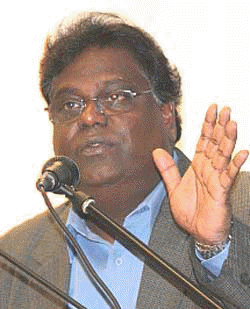 Dr. Murugar Gunasingam has authored three books including the critically acclaimed
Dr. Murugar Gunasingam has authored three books including the critically acclaimed 